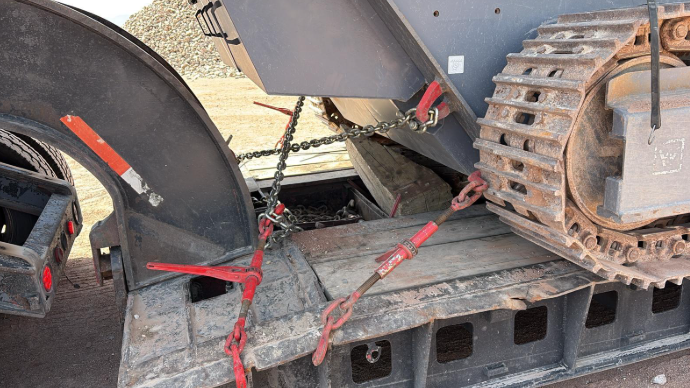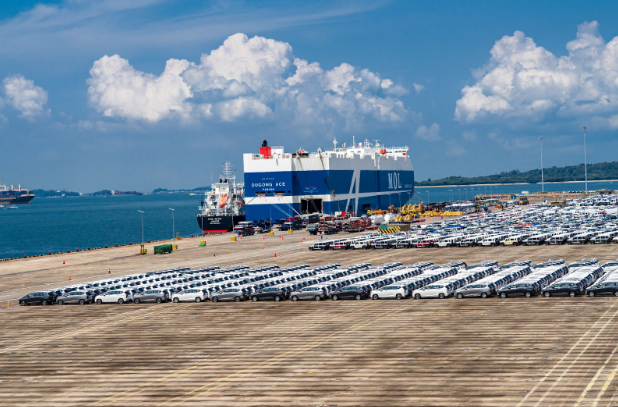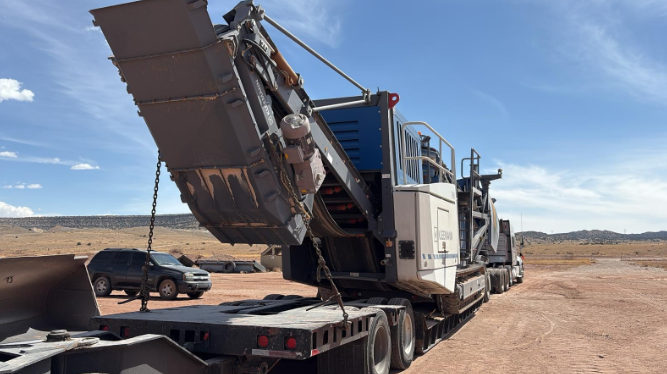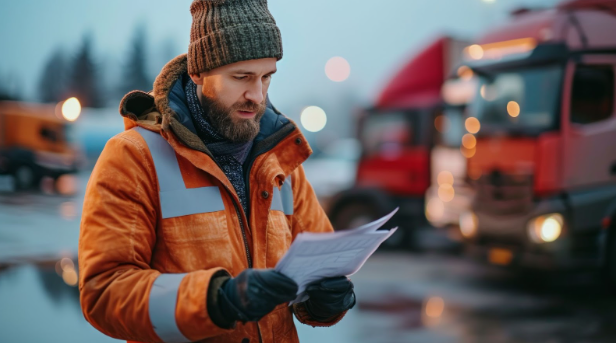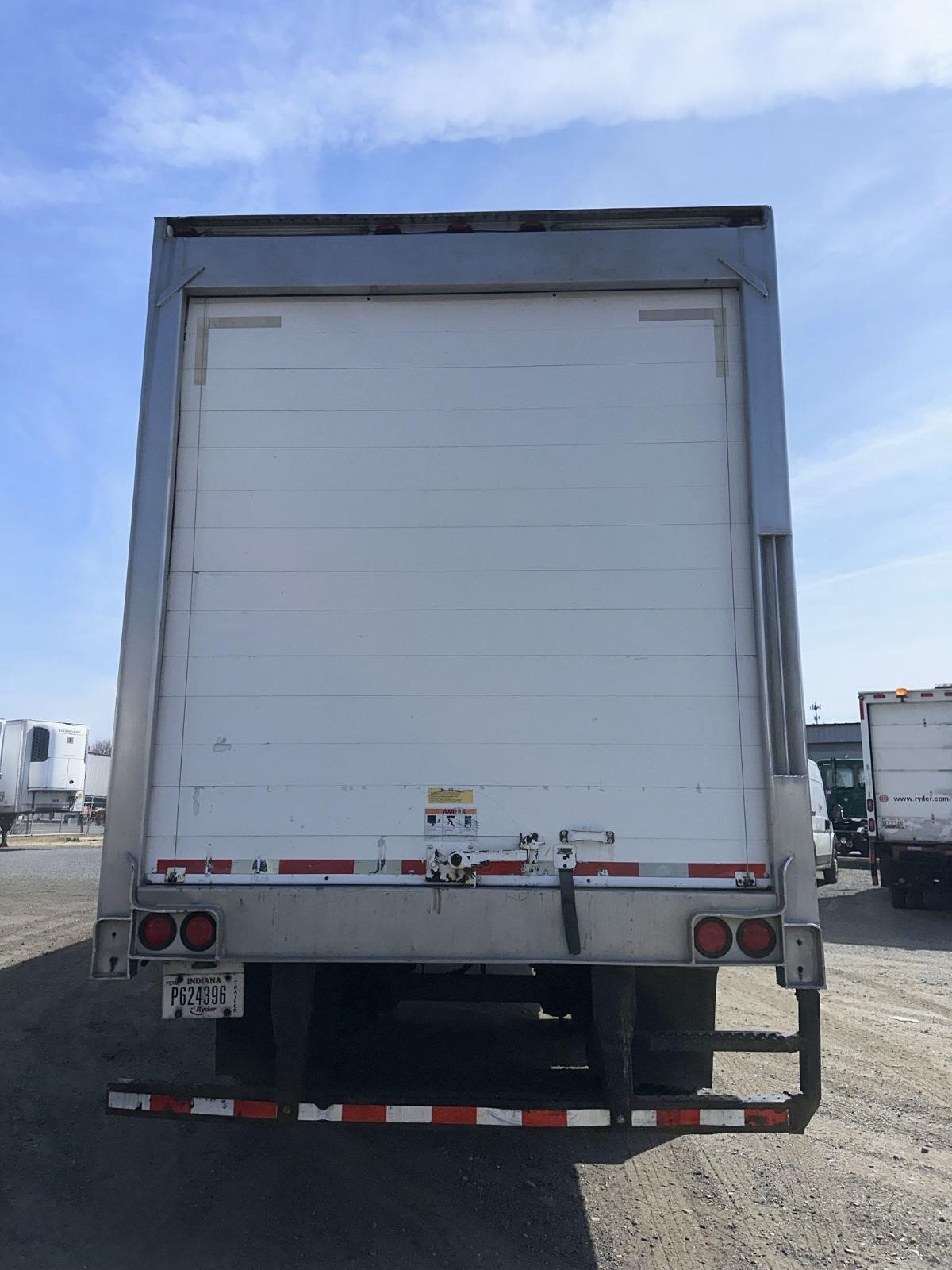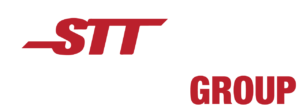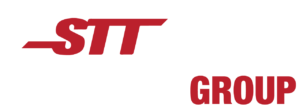A 118,000 lb Kleemann comb crusher secured onto a lowboy trailer with chains in the New Mexico desert
When a load shifts mid-transit—especially at highway speeds of 90 km/h or more—the consequences can unfold in seconds. You may be looking at damaged cargo or jackknifed trailers, and in the worst cases lives may even be lost. In short, load securement is a very serious business..
Yet too often, securement is treated as routine. Seasoned carriers know better. They understand that the right gear and methods keep freight stable, drivers safe, and businesses moving.
In this post, we’ll cover what securement really means, the laws that govern it, the tools you’ll need, and the emerging tech changing the game.
| Key Takeaways: Load securement is essential for safety, compliance, and cargo protection. Federal regulations include cargo-specific rules and working load limit (WLL) calculations. Violations can cost carriers thousands of dollars and lead to long-term business consequences. Proper equipment, training, and inspections are non-negotiable. New tech—from smart sensors to AI route planning—is transforming securement strategies. |
Load Securement Fundamentals
At its core, load securement is the practice of keeping cargo immobile during transport. It’s not simply a case of throwing a few straps over a load and hoping for the best. Effective securement involves an understanding of physics—specifically, how weight, center of gravity, and acceleration forces interact with securing systems during transit.
Different cargo types behave in unique ways. A flat pallet of lumber is not going to respond to movement the same way a rounded metal coil or a piece of heavy machinery does. That’s why seasoned carriers reject one-size-fits-all methods. Instead, they use cargo-specific strategies involving:
- Tie-downs: Direct or indirect restraints depending on the type of load.
- Blocking and bracing: Strategic placement to fill gaps and limit movement.
- Dunnage: Materials used to cushion and stabilize loads.
The aim of securement? To eliminate any forward, backward, or lateral movement—especially during abrupt stops or evasive maneuvers. And achieving this requires more than muscle; it demands a strategy based on the cargo’s characteristics and the journey ahead.
| How Heavy Machinery Becomes a Missile at Speed Let’s take a 20,000 lb (9,072 kg) piece of heavy machinery—like a medium-sized excavator or bulldozer. If that load isn’t properly secured and you’re traveling at 70 mph (113 km/h), its momentum can turn it into a destructive force of over 3 million Newtons on impact during a sudden stop. That’s roughly equivalent to being hit by: A commercial jet landing at full speed A herd of 400 rhinos charging at once A small building collapsing |
Federal Regulations: What You Must Know
The FMCSA’s cargo securement rules under Title 49 CFR, Part 393, provide a detailed framework for securing freight safely and legally. These rules are not up for interpretation—they’re measured and enforced, and failure to comply can result in significant penalties.
Here are the basics every carrier must know:
- Performance Requirements: Securement systems must withstand 0.8g forward, 0.5g rearward, and 0.5g lateral forces. Translation? Your cargo must stay firmly put even if you brake hard or swerve unexpectedly.
- Working Load Limits: The total WLL of tie-down devices must be at least 50% of the weight of the cargo.
- Tie-Down Minimums: Cargo under 5 feet and 1,100 lbs. requires one tie-down. Larger loads need two or more—plus extra tie-downs for every additional 10 feet.
Industry standards from groups like the Web Sling and Tie Down Association and National Association of Chain Manufacturers are often incorporated into federal rules. These help clarify the specs carriers need to follow for straps, chains, wire rope, and other gear.
| Force Generated During Emergency Braking According to FMCSA standards, securement systems must withstand: 0.8g of forward deceleration Which means a 20,000 lb load must resist at least 16,000 lbs of forward force If it isn’t strapped down with proper working load limit (WLL) calculations, it can: Slide through the trailer wallCrush a cab Endanger lives on the road or at delivery sites |
Photo by Ratchapon Supprasert on Vecteezy: An unsecured trailer strap may seem minor—but on the road, it can be the first link in a chain of serious consequences. Always double-check every fastening point before departure.
Common Load Securement Violations—and What They Cost
Violations in this area are all too common—and entirely avoidable. Some of the most frequent issues include:
- Insufficient Tie-Downs: Failing to meet the minimum number based on size and weight.
- Damaged or Non-Compliant Equipment: Using worn straps, rusted chains, or gear without labeled WLLs.
- Improper Use: Securing cargo to unstable anchor points or using tie-downs incorrectly.
What’s the damage?
For violations, you’re looking at fines from $1,000 to $10,000. Penalties increase for repeat offenses or violations that contribute to accidents. But the true cost goes beyond the checkbook:
- Out-of-service orders
- Higher CSA scores and insurance premiums
- Civil liability for accidents
- Loss of contracts and customer trust
Worse yet, news of a violation can ripple through the industry fast, damaging your brand and your ability to compete.
Essential Load Securement Equipment
Good gear is the cornerstone of safe transport. It needs to meet DOT standards, be clearly marked with WLLs, and be regularly inspected for wear and damage.
Core Securement Tools:
- Ratchet Straps: Versatile and ideal for lighter freight.
- Chains and Binders: Best for heavy machinery or dense cargo.
- Wire Rope: Useful for high-tension scenarios.
But securing cargo goes beyond the basics. Accessories, too, play a big role in creating a complete securement system:
- Friction Mats: Increase grip between cargo and trailer deck.
- Edge Protectors: Prevent straps from cutting into cargo and extend strap life.
- Shoring Bars and Dunnage: Fill space and support cargo from shifting in transit.
Using the right combination of equipment guarantees stability, protects cargo, and meets regulatory standards. For more practical insights into how these regulations apply on the ground, this guide from US Cargo Control breaks down the essentials of DOT-compliant securement gear.
Best Practices by Cargo Type
For carriers looking to elevate their practices, safety enhancements can reshape the way heavy freight is secured and transported. Every load has its own quirks, so what works for one might fail spectacularly for another.
For instance, securing a bulldozer with nylon straps instead of heavy-duty chains might hold steady in the yard—but hit a steep downhill grade at 80 km/h, and those straps could snap like rubber bands under the weight and momentum. Suddenly, you’re not hauling heavy machinery—you’re trying to stop it from bulldozing through the cab.
That’s why load-specific securement is absolutely essential. Here’s a breakdown of securement best practices for common freight types:
Heavy Machinery
- Use chains with WLL ratings above the equipment’s weight.
- Secure at designated anchor points—not improvised ones.
- Block wheels or use chocks to prevent rolling.
Metal Coils
- Use V-shaped supports or coil cradles to stabilize the roll.
- Employ direct tie-downs to prevent forward/backward movement.
- Prevent rotation with well-placed bracing and lateral restraints.
Lumber and Building Materials
- Stack layers evenly with dunnage between tiers.
- Secure against both forward and lateral movement.
- Ensure top layers are not loose or able to shift mid-transit.
Intermodal Containers
- Use twist locks at all four corners when transported on container chassis.
- Add tie-downs when moved on flatbeds or non-standard trailers.
- Check lock integrity before and during transit.
The Role of Driver Training and Inspections
Load securement starts with education. Carriers must go beyond simply telling drivers what to do—instead, they should help them understand why it matters. Effective training covers:
- Federal securement rules
- Correct use of equipment
- How to assess different cargo types
- Real-world scenarios and problem-solving
Inspection Protocols
- Pre-Trip: Inspect all securement devices, ensuring correct tension and placement.
- Within First 50 Miles: Cargo often settles in the early stages of transit. This check is crucial.
- Every 150 Miles or 3 Hours: Regular re-checks help catch problems before they escalate.
Some forward-thinking carriers are even turning to VR simulation training, giving drivers the chance to test their skills in dynamic, high-stakes scenarios—without real-world risk.
The FMCSA’s CSA Safety Planner provides cargo-specific guidance, including a dedicated section on load securement subsections that help reinforce best practices and compliance.
Transforming Load Securement Through Tech
Load securement is no longer only about muscle and metal—today’s transport industry is embracing a digital edge, where smart sensors, AI, and automation are transforming how cargo stays safe on the road. Here’s how:
Smart Load Monitoring Sensors
These devices track cargo movement and send alerts if shifting occurs. They act as real-time safeguards—particularly helpful for long hauls or high-value freight.
Automated Tensioning Systems
These systems adjust tension on tie-downs during the trip, maintaining consistent pressure even as loads settle or stretch occurs. It’s a hands-off solution for better security.
AI Route Planning
In analyzing road conditions, weather, and cargo requirements, AI can recommend safer routes that reduce the risk of sharp turns, steep grades, or abrupt stops. This is hugely beneficial for both the cargo and the crew.
Final Thoughts: Safety is the Real Return on Investment
Load securement isn’t just about ticking regulatory boxes. It’s about delivering on your promises—safely, consistently, and without incident. Carriers that treat securement seriously don’t just avoid fines—they build reputations that win contracts, retain clients, and save lives.
Today’s most respected fleets invest in:
- Quality gear
- Robust training
- Technological tools
- Clear, repeatable procedures
Why? Because in transport, a properly secured load proves that your business is built on safety, not shortcuts.
